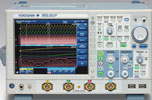

The DLM6000 mixed-signal oscilloscope is the flagship product in Yokogawa’s new family of high-performance digital oscilloscopes featuring bandwidths up to 1,5 GHz, memory of 6,25 million points per channel, an intuitive graphical user interface and a number of advanced analysis features.
The new oscilloscope family consists of five 4-channel models: the two DLM6000 mixed-signal oscilloscopes with 16- or 32-bit logic capability and bandwidths of 500 MHz and 1 GHz; and three DL6000 versions with bandwidths of 500 MHz, 1 GHz and 1,5 GHz, respectively. All the instruments have a maximum sampling rate of 5 GSps, apart from the DL6154 1,5 GHz instrument with 10 GSps. The 16/32-bit logic inputs on the DLM6000 series models have a maximum toggle rate of 250 MHz or 100 MHz, depending on the probe used.
The new user interface, based on extensive market research including detailed feedback from users, aims to make the instruments very easy to use. It incorporates a new physical layout with backlit buttons, new on-screen visual elements including graduated menus, and innovative controls including a four-direction selector button and a ‘jog shuttle’ control. In addition to the ease of use provided by the new user interface, the oscilloscopes offer an extensive range of capabilities for waveform characterisation, powerful tools for detecting glitches and anomalies, advanced signal enhancement and noise reduction technologies, and a range of options for serial bus analysis and power measurement.
The combination of 32-bit logic inputs and four high-speed analog channels makes the mixed-signal models ideally suited for the testing and debugging of embedded systems, while the built-in Windows capability along with a range of software drivers means that the instruments can be integrated into automated test systems. Advanced logic analysis capabilities include state display, a ‘virtual D/A’ feature that calculates the analog signal from the logic information and displays the result on screen, and bus bundle and symbolic decoding facilities. Moreover, the DLM6000 samples the logic channels simultaneously with the analog channels and at the same maximum speed.
The instruments feature high-speed acquisition and quick response, with an update rate of up to 25 000 waveforms per second, a history memory function for more efficient waveform observation and analysis, and powerful zoom and search functions. The history memory function allows the user to recall and display previously acquired data from up to 2000 screens’ worth of past waveforms. Also included are powerful functions for searching the memory for desired waveforms, and zoom functions for observing these waveforms in detail. In addition to searching based on criteria such as signal edge, pulse and multichannel state, the history memory can be searched by serial or parallel waveform patterns and waveform parameters. Users can find desired waveform data in memory, enlarge the area with the zoom function, and scroll the data.
A dual-window zoom function simultaneously zooms in on two areas. Two individual zoom factors and positions can be set with independent timescales and displayed simultaneously. Using the automatic scroll function, it is possible to automatically scroll waveforms captured in long memory and change the position of the zoom areas. Trigger functions include the ability to trigger conditions using a logic signal as the source. Various trigger conditions can be combined to capture only the desired signals.
Signal enhancement capabilities include new IIR and FIR bandwidth filtering, a high-resolution mode, averaging and real-time maths channels. Serial bus analysis options allow analysis to be carried out on I2C, SPI, CAN LIN and UART bus systems, with triggers for these bus types included in the package. Hardware acceleration enables serial bus analysis to be carried out in real-time; this capability makes it easy to discriminate between partial software failures and physical-layer waveform problems when troubleshooting systems by observing the physical-layer characteristics of signals. With the dual-window zoom function, the instruments can simultaneously analyse and display waveforms from buses running at different speeds.
For more information contact Trevor Grundlingh, Protea Electronics, +27 (0)11 719 5700, [email protected], www.protea.co.za

© Technews Publishing (Pty) Ltd | All Rights Reserved